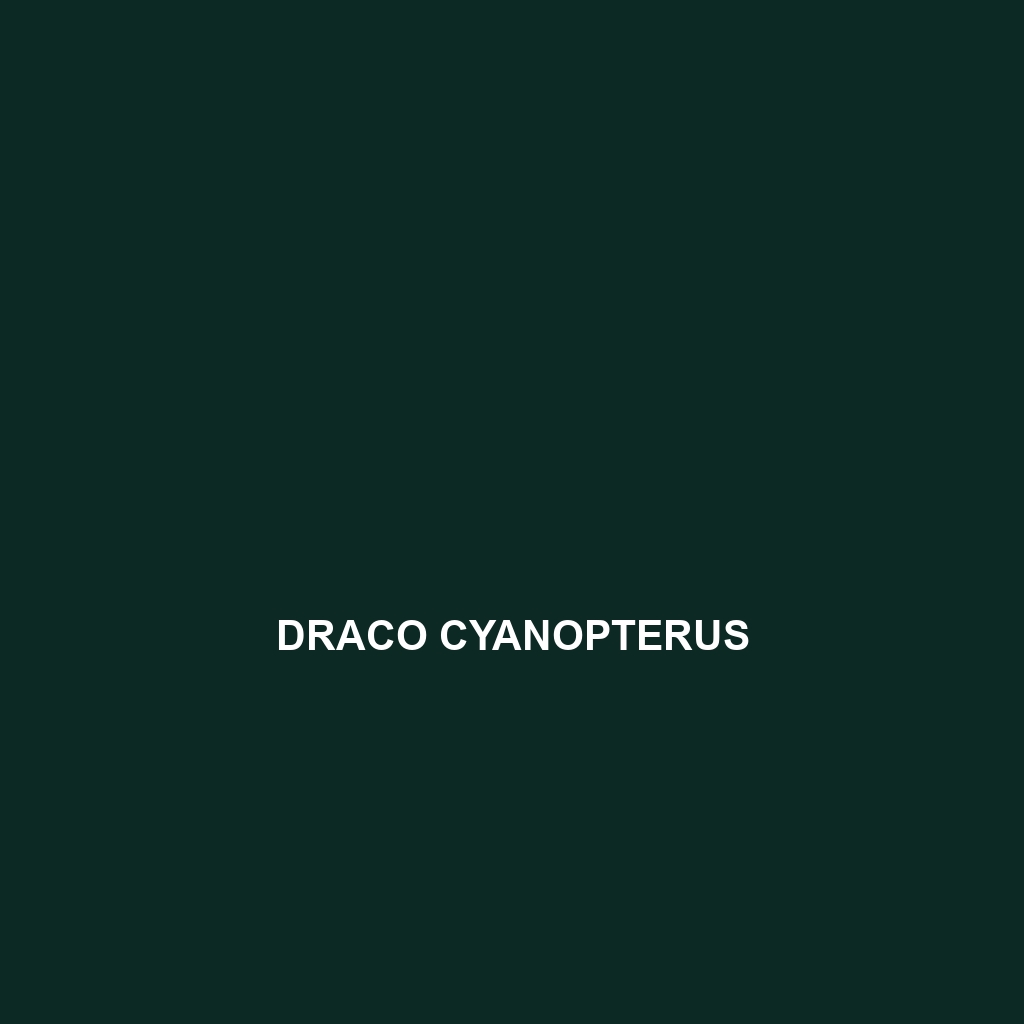Common Name
Draco cyanopterus
Scientific Name
Draco cyanopterus
Habitat
The Draco cyanopterus, commonly known as the blue-winged flying dragon, is primarily found in the tropical rainforests of Southeast Asia. This species thrives in humid, dense forests, preferring areas with abundant foliage that provide essential cover and perching sites. The geographic range includes countries such as Malaysia, Indonesia, and the Philippines, where warm temperatures and high humidity levels create ideal living conditions. These lizards are often spotted gliding between trees in shaded environments, demonstrating their remarkable adaptation to forest habitats. Additionally, the prevalence of rainforests allows Draco cyanopterus to utilize its unique gliding abilities to travel significant distances in search of food and mates, making it a fascinating subject for biological studies.
Physical Characteristics
Draco cyanopterus showcases distinct features that set it apart from other lizard species. Generally, these lizards measure between 20 to 30 centimeters in length, including their tail, which is generally longer than their body. One of their most striking characteristics is the pair of elongated, colorful “wings” formed by elongated ribs that support a flap of skin, allowing them to glide gracefully from tree to tree. The dorsal side is typically vivid green, which provides excellent camouflage against foliage, while the wings exhibit a brilliant blue hue that plays a crucial role in mating displays and territorial behaviors. Their elongated, slender body helps streamline their movement through the air as they glide, enhancing their ability to escape predators.
Behavior
Diet
Draco cyanopterus is primarily insectivorous, feeding on a variety of small insects, including ants, termites, and beetles. Their diet is essential for maintaining the ecological balance within their habitat, as they help regulate insect populations. Although predominantly insect eaters, these lizards are sometimes observed consuming plant matter, showcasing an omnivorous tendency, especially during times when insect availability is low. Their feeding patterns are opportunistic, often involving stealthy movements and quick lunges to capture prey, which highlights their adaptability in securing food sources.
Reproduction
The reproductive cycle of Draco cyanopterus typically occurs during the rainy season, when environmental conditions are most favorable. Mating rituals include elaborate displays of color and movement, with males often taking center stage. The gestation period lasts approximately 30 to 50 days, after which females lay a clutch of around 3 to 7 eggs in a secure, hidden location, often within the leaf litter or crevices of tree bark. Parental care is minimal, as the hatchlings are precocial, meaning they are relatively independent upon emergence. Young lizards rapidly develop and adopt adult characteristics as they transition into the juvenile stage.
Conservation Status
The conservation status of Draco cyanopterus is currently classified as Least Concern according to the International Union for Conservation of Nature (IUCN). However, ongoing habitat loss due to deforestation and urbanization poses significant threats to their population stability. Conservation efforts in Southeast Asia focus on preserving rainforest habitats and implementing sustainable land-use practices to ensure the survival of this unique species and its ecosystem. Further studies are warranted to monitor populations and assess potential vulnerabilities in specific regions.
Interesting Facts
Draco cyanopterus captivates herpetologists and nature enthusiasts alike due to its remarkable adaptations for aerial locomotion. One unique adaptation is its ability to flatten its body and extend its wing flaps to enhance gliding capability, achieving a controlled descent. Another intriguing fact is its coloration, which not only serves as camouflage but also plays a pivotal role in attracting mates. Unlike many reptiles, these lizards engage in social interactions that are visually rich and display a level of complexity that is not commonly observed in other lizard species.
Role in Ecosystem
Draco cyanopterus plays a vital role in its ecosystem as both a predator and prey. As an insectivore, it helps control insect populations, thereby contributing to the health of the rainforest ecosystem. Furthermore, being a part of the food web, these lizards serve as prey for larger birds and mammals. They can also influence plant growth indirectly through their feeding habits, which assist in seed dispersal and pollination—a testament to their significance as ecological participants. Their intriguing gliding capabilities allow them to traverse diverse niches within the rainforest, creating an interconnected network that sustains biodiversity.
